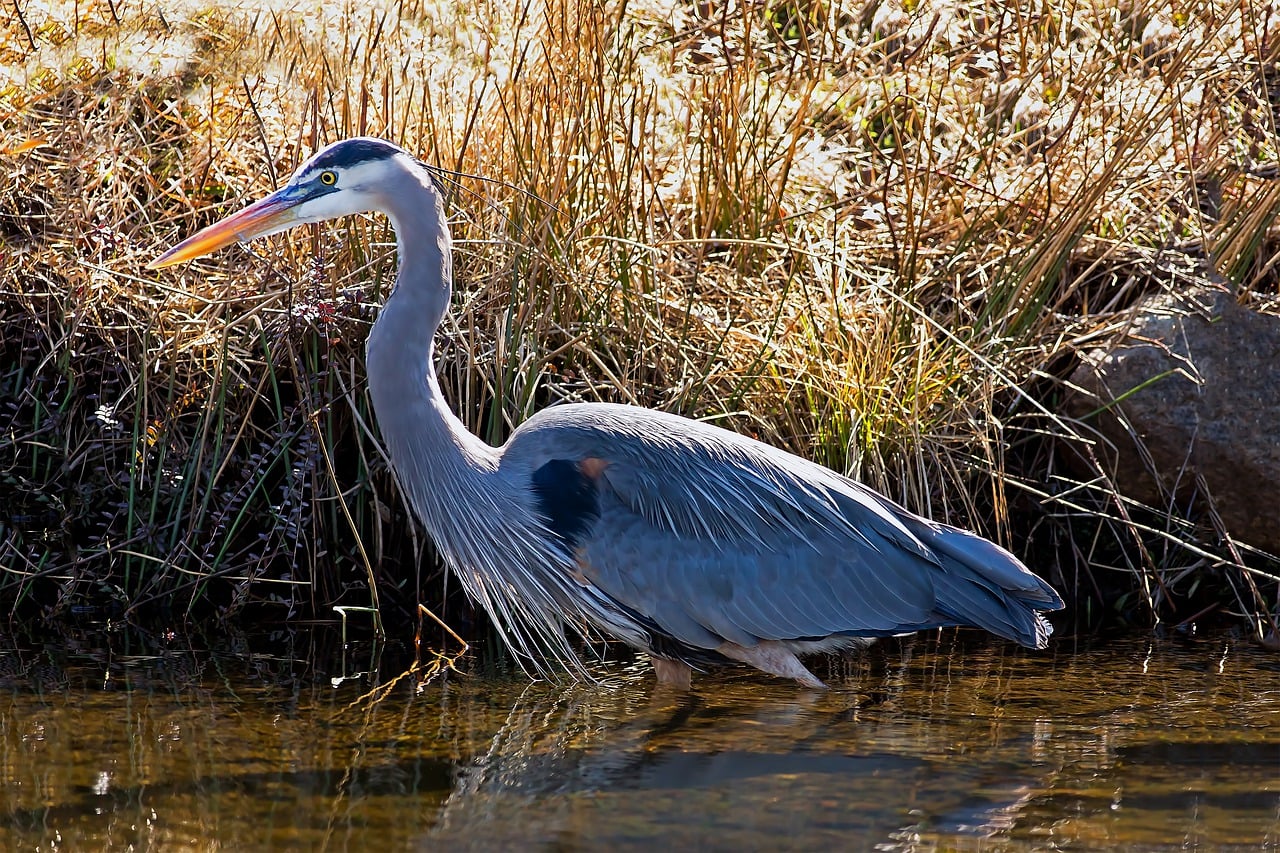Great Blue Heron: Field Guide, Pictures, Habitat & Info
Last Updated on

Whether you see it in flight or gracefully gliding across the water, the Great Blue Heron is a majestic sight. The lifespan of the gorgeous bird is between 15 and 23 years, and you can find them gliding in marshes and nesting in trees.
If you want to know more facts about the Great Blue Heron, we’ll give you a few of them and more in the guide below.

Quick Facts about Great Blue Heron
| Habitat | Marshes |
| Diet | Fish |
| Behavior | Stalking |
| Nesting | Tree |
| Conservation | Low concern |
| Scientific name | Ardea herodias |
| Lifespan: | 15 to 23 years |
Great Blue Heron General Description
The Great Blue Heron is a stately, elegant bird with blue-gray plumage and long legs. It’s the largest bird in North America and is not difficult to identify. The breed has a six-foot wingspan and distinctive black eyebrows.

Great Blue Heron Range, Habitat, Behavior, Diet & Nesting
Now that you know what to look for when it comes to the Great Blue Heron, we’ll tell you a bit about the bird’s range, habitat, behavior, diet, and nesting.
Range
The Great Blue Heron covers a range spanning from North America to Central America and can adapt to almost any habitat in that range.
You can find this majestic breed in marshes, flowering trees, lake edges, shorelines, and near swamps and flooded meadows.
Habitat
Herons forage near marshes and shorelines and adapt to nearly any environment. They prefer looking for food in areas that are free of predators.

Behavior
These majestic creatures hunt by wading up to their bellies in water and spearing fish with their sharp spear-shaped bills. You can also find them diving feet-first into a marsh or lake to impale their prey.
Diet
Herons prefer fish, but they will dine on frogs, turtles, snakes, salamanders, rodents, birds, and even insects. They’ve also been known to stalk gophers and moles in fields around their nest.
Nesting
The nesting habits of the Great Blue Heron are pretty simple. They nest in colonies, often with other wading birds. However, you rarely see them nesting in pairs that are isolated. The males choose the nesting site and use it to attract the females.
How to Find Great Blue Heron: Birdwatching Tips

Are you wondering where to find the Great Blue Heron? Read on below for a few birdwatching tips to follow.
What to Listen For
When searching for the Great Blue Heron, you should listen carefully for a loud, rusty squawk. Since this will be coming from a flock of birds, it shouldn’t be hard to pick up on.
What to Look For
The Great Blue Heron is often found near shorelines and marches searching for fish. Because of their massive size and fondness for gathering in flocks, Herons are not usually hard to identify.
When to Look
Great Blue Herons are more visible in the summer. The birds are usually gone before you know it, so make sure to catch them before the end of June.

Attracting Great Blue Heron to Your Backyard: Tips & Tricks
If you’re trying to attract these gorgeous birds to your backyard, we have a few tips and tricks you can follow.
- Stock your pond with catfish, bass, bluegill, largemouth bass, and crappy if you want to attack Herons.
- Plant cattail, sedges, and rushes around your pond or another water feature to attack the birds.
- Add nest boxes and bird feeders that will attract the birds near the pond.
- Your property should have several tall trees and a water source if you want to attract a flock of Herons.
Great Blue Heron Conservation: Is This Bird Threatened?
The Great Heron is not threatened and is considered a low-concern species. However, some researchers believe their numbers are decreasing because their habitat is being destroyed.
Georgia and North Carolina have been designated as critical habitat areas where Herons and other seabirds are protected.


Conclusion
Although you’re unlikely to spot a Blue Heron in the winter, the massive birds stay busy finding mates and foraging for seafood in the summer. Watching a Heron catch a fish is an unforgettable experience, and if you live near coastal areas in their range, you’re likely to spot the birds feeding and tending their nests.
Featured Image Credit: khw80, Pixabay
Table of Contents
About the Author Patricia Dickson
Patricia is an animal and coffee writer and a published author under the pen name Skylar McKinzie. When she isn’t writing, Patricia enjoys spending time with her two cats and dog. Since she was a young child, she has been a pet lover and enjoys nothing more than cuddling with her pets. Patricia loves sharing her knowledge of animals and finds joy in helping out at the local rescue shelter whenever she can.
Related Articles:
10 Types of Hummingbirds in Arkansas (With Pictures)
8 Types of Hummingbirds in Nebraska (With Pictures)
5 Types of Hummingbirds in Idaho (With Pictures)
3 Types of Hummingbirds in Mississippi (With Pictures)
8 Types of Hummingbirds in Kansas (With Pictures)
5 Types of Hummingbirds in West Virginia (With Pictures)
5 Types of Hummingbirds in Ohio (With Pictures)
Where Do Nuthatches Nest? Nuthatch Nesting Habits Explained
